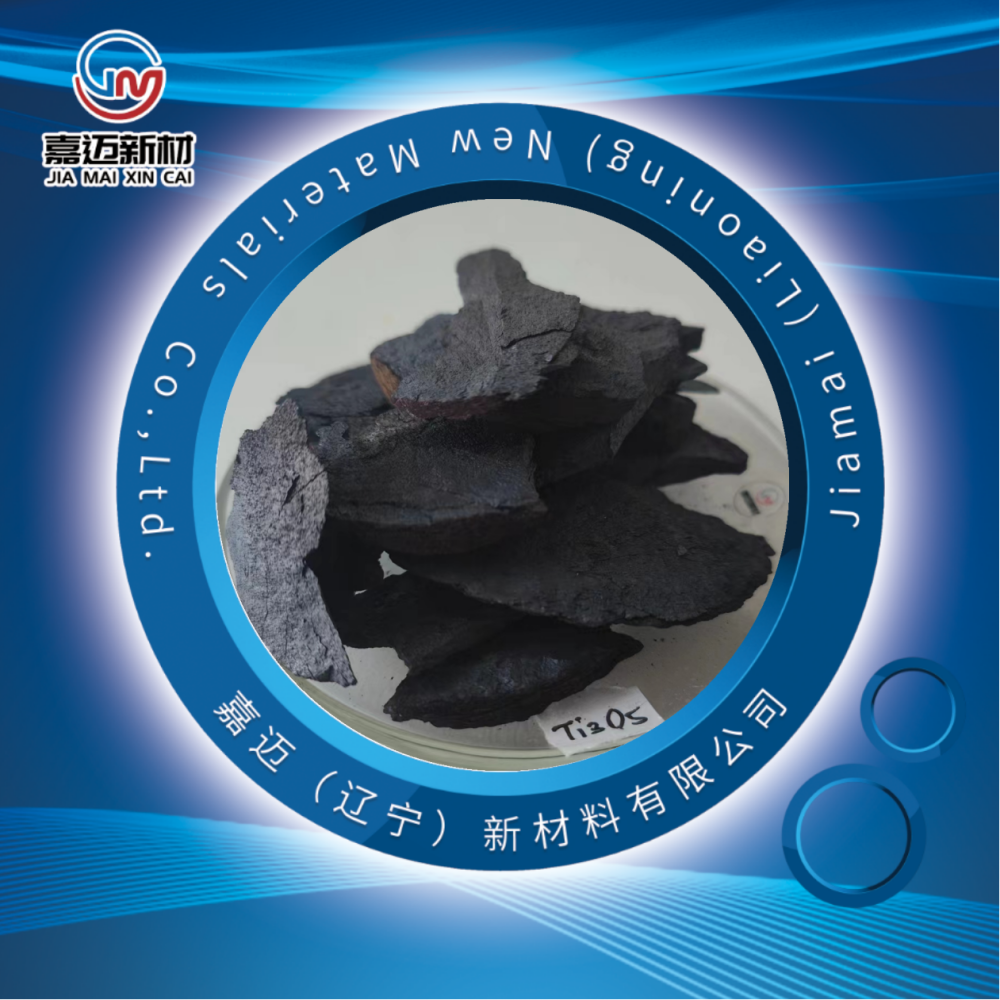
1、 Basic characteristics of titanium pentoxide
A. Chemical Structure and Crystal Structure
Titanium pentoxide (Ti3O5) is an important oxide material with a chemical formula of Ti3O5. In terms of molecular structure, it is composed of three titanium atoms and five oxygen atoms, and has a complex crystal structure. Ti3O5 has various homogeneous and heterogeneous crystals, but the most common structure is the monoclinic system, which endows it with unique physical and chemical properties.
In terms of crystallographic characteristics, the lattice parameters of Ti3O5 vary due to the differences in its homogeneous and heterogeneous crystals. The most common form of β - Ti3O5 has the following lattice parameters: a=0.97 nm, b=0.93 nm, c=0.63 nm, β=108 °. This crystal structure gives Ti3O5 good stability and diversity in applications.
B. Physical properties
optical properties
Titanium pentoxide exhibits excellent optical properties, with a refractive index of approximately 2.4, making it an ideal choice for various optical applications. In terms of transparency, Ti3O5 exhibits good transparency in the visible and near-infrared spectral ranges, especially in the wavelength range of 400 nm to 700 nm.
Mechanical properties
The hardness and wear resistance of titanium pentoxide are also excellent. Its Vickers hardness is about 700 HV, making it perform well in high stress and high wear environments. Therefore, Ti3O5 is widely used in the field of protective coatings that require high wear resistance.
electrical properties
In terms of electrical performance, Ti3O5 has relatively high conductivity and moderate dielectric constant. Its conductivity is about 10 ^ -6 S/cm, and its dielectric constant is between 20 and 25. These characteristics make it have broad application potential in electronic components, such as capacitors and semiconductor devices.
2、 Application of Titanium Pentoxide in Coating Technology
A. Optical coating
Anti reflective coating
Titanium pentoxide is often used as an anti reflective coating due to its high refractive index and good transparency. By coating a thin layer of Ti3O5 on the surface of glass or plastic, light reflection can be significantly reduced and transmittance can be improved, which has important applications in optical devices such as eyeglass lenses and camera lenses.
Mirror coating
Ti3O5 is also widely used in mirror coatings. Its high reflectivity makes it an ideal material for mirrors in telescopes and laser systems. By depositing a layer of Ti3O5 on the mirror surface, the reflection efficiency and durability of the mirror surface can be improved.
Filter coating
Filter is a key component in optical systems, used to selectively filter light of specific wavelengths. The unique optical properties of titanium pentoxide make it an ideal material for manufacturing optical filters, especially in multi-layer interference filters where the Ti3O5 layer can precisely regulate the transmission and reflection characteristics of light.
B. Protective coating
Wear resistant coating
The high hardness and wear resistance of titanium pentoxide make it important for use in protective coatings. By coating a layer of Ti3O5 on the surface of metal or ceramic, its wear resistance can be significantly improved, which is particularly important for applications in high wear environments such as cutting tools, mechanical parts, and spacecraft components.
Anti corrosion coating
Ti3O5 also performs well in terms of corrosion resistance. Its chemical stability enables it to effectively prevent oxidation and corrosion of metal surfaces. By depositing Ti3O5 coating on the metal surface, the service life of metal components can be extended and maintenance costs can be reduced.
C. Application in electronic components
capacitor
In capacitor manufacturing, Ti3O5 is often used as a dielectric material due to its high dielectric constant. This high dielectric constant material can significantly increase the capacity of capacitors, thereby storing more charge in the same volume.
semiconductor device
Ti3O5 also has important applications in semiconductor devices. Its electrical properties make it suitable for use as a semiconductor thin film material, which can effectively improve the performance and reliability of devices. For example, in field-effect transistors (FETs), Ti3O5 thin films can serve as insulating layers, providing excellent electrical performance and stability.
3、 Preparation method of titanium pentoxide coating
A. Physical Vapor Deposition (PVD)
Magnetron sputtering
Magnetron sputtering is a commonly used method in physical vapor deposition (PVD), which uses a magnetic field to guide an ion beam to bombard a titanium pentoxide target material in a vacuum environment, causing its atoms to sputter onto the surface of the substrate to form a thin film. This method has the advantages of high deposition rate, dense and uniform film layer, and is suitable for large-area coating.
Evaporative coating
Evaporative coating is another common PVD method, which involves heating titanium pentoxide in a vacuum environment to evaporate and deposit it on the surface of the substrate to form a thin film. The evaporation coating process is simple and suitable for various substrates, but the deposition rate is relatively low, and the uniformity of the film layer is limited by equipment accuracy.
B. Chemical Vapor Deposition (CVD)
Low pressure chemical vapor deposition (LPCVD)
Low pressure chemical vapor deposition (LPCVD) converts gaseous precursors into solid thin films through chemical reactions in a low-pressure environment. LPCVD has the advantages of high deposition rate and good film uniformity, and is commonly used in large-scale industrial production.
Plasma enhanced chemical vapor deposition (PECVD)
Plasma enhanced chemical vapor deposition (PECVD) enhances the chemical reaction rate and improves deposition efficiency by introducing plasma. PECVD is suitable for preparing high-quality thin films, especially in applications that require low-temperature deposition, such as flexible electronic devices.
C. Sol gel method
Sol gel process
The sol gel method is a wet chemical preparation method. The precursor is dissolved in the solvent to form a sol. After hydrolysis and condensation, the gel is formed, and then the Ti3O5 film is obtained through drying and heat treatment. This method is easy to operate, cost-effective, and suitable for laboratory research and small-scale production.
Application examples
Sol gel method is widely used to prepare optical coatings and protective coatings. For example, Ti3O5 antireflection coating prepared by sol-gel method has good light transmittance and durability, and has been widely used in optical devices.
4、 Application examples of titanium pentoxide coating
A. Solar cells
Increase photoelectric conversion efficiency
In solar cells, titanium pentoxide coating can significantly improve the photoelectric conversion efficiency. The high refractive index and transparency of Ti3O5 enable it to effectively reduce light reflection, increase light absorption, and thus improve photoelectric conversion efficiency.
Reduce reflection loss
By coating a layer of Ti3O5 anti reflective coating on the surface of solar cells, it is possible to significantly reduce light reflection loss, increase light absorption, and further improve the efficiency of solar cells.
B. Display Technology
Applications in LCD and OLED screens
In display technology, titanium pentoxide coating is widely used in liquid crystal displays (LCD) and organic light-emitting diode (OLED) screens. The high transparency and anti reflection properties of Ti3O5 make it an ideal coating material for display screens, which can improve display performance and screen brightness.
C. Biomedical field
Biocompatible coating
In the biomedical field, Ti3O5 is widely used as a coating material for medical devices due to its excellent biocompatibility. By coating the surface of medical devices with a layer of Ti3O5, it is possible to reduce the rejection reaction of organisms to the devices and increase their service life.
Medical Device Coatings
Ti3O5 coating is also used to manufacture highly wear-resistant and corrosion-resistant medical devices, such as surgical knives and implants. Its excellent physical and chemical properties make it perform well in harsh biomedical environments.





